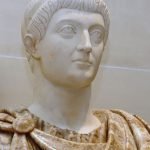A giant 3D replica of Emperor Constantine is located near the museum, which houses the original fragments of Constantine’s giant feet, hands and head, discovered by archaeologists.
It is a massive, 13-meter-high replica of the statue that Constantine commissioned for himself after 312 CE. 3D modelling technology was used to create the replica, based on scans of nine gigantic, original marble body parts that remained from archaeological discoveries. The result of this work is an impressive figure of the seated emperor, dressed in a gilded tunic, holding a sceptre and orb, looking over Rome from the side garden of the Capitoline Museum.
The reconstructed statue is located just around the corner from the museum’s courtyard. Officials would not reveal how much the initiative cost, but the replica was made by the Factum Foundation, a Madrid-based nonprofit that creates high-resolution digital replicas of world cultural heritage. The statue itself is made of resin, polyurethane marble powder (body) and gold leaf and plaster (tunic). A second version of the monument is to be installed in northeast England, where Constantine oversaw the fortifications of Hadrian’s Wall before he was proclaimed emperor.







